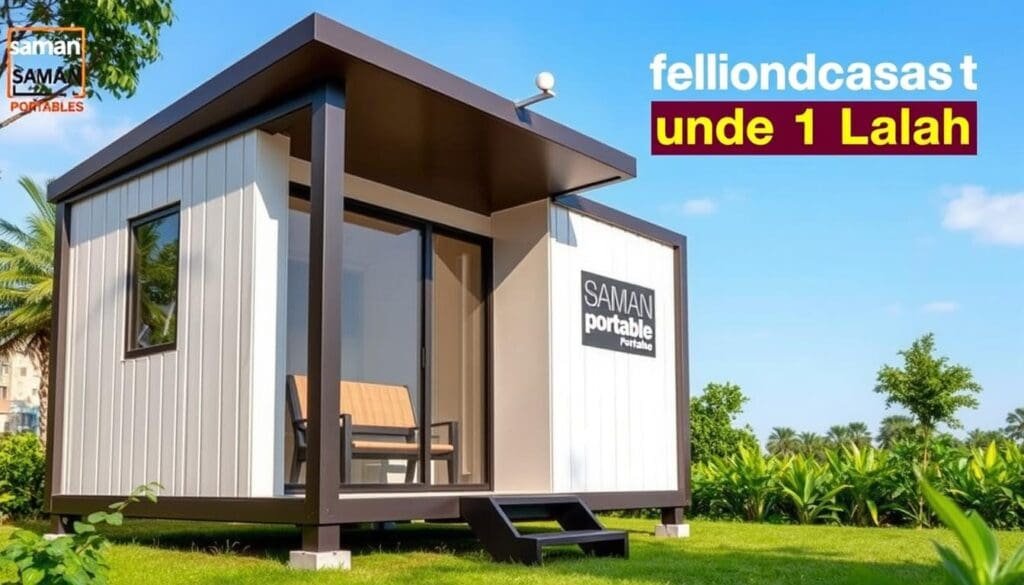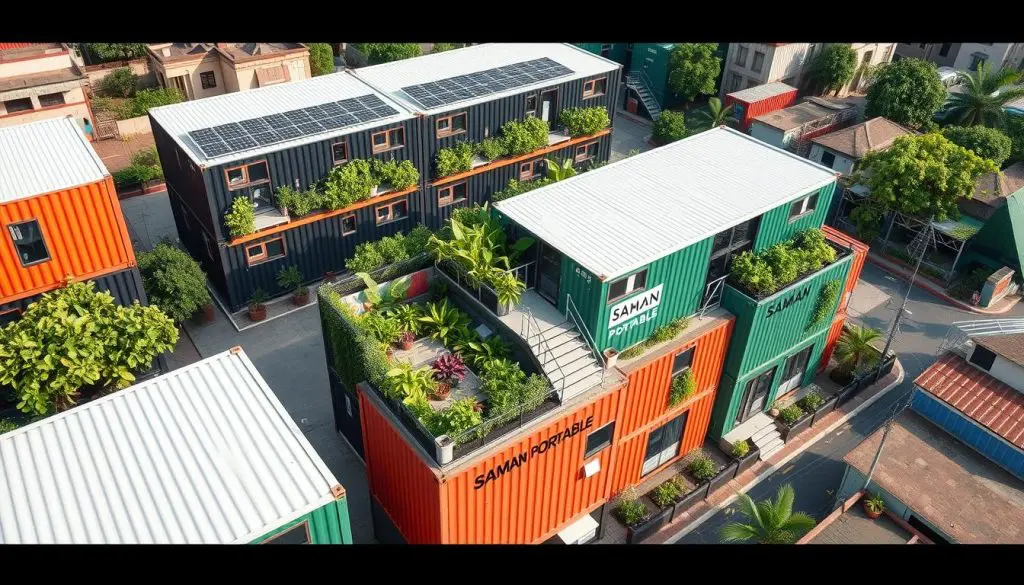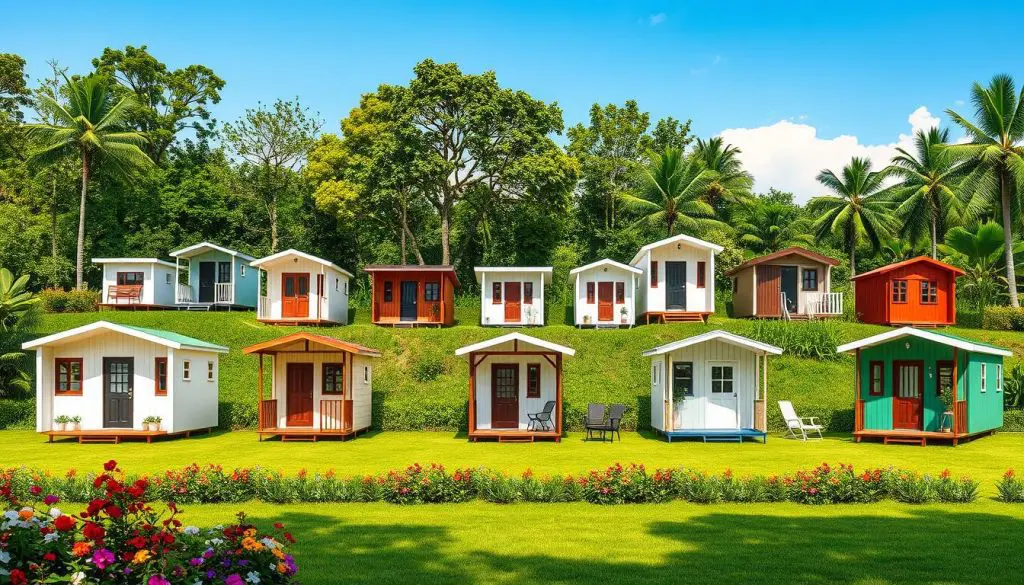Innovative Home Solutions: Exploring the Benefits of Shipping Container Houses
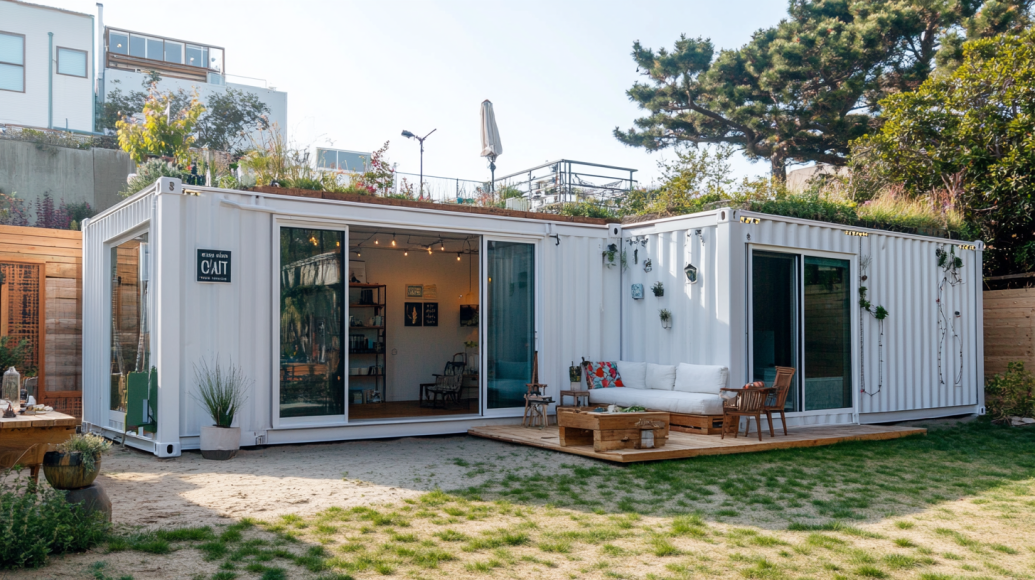
Cost-Effective Construction: How Shipping Container Houses Reduce Building Expenses
Shipping container houses offer a cost-effective construction solution that significantly reduces building expenses. Firstly, these homes start with an existing structure, the shipping container itself, which costs between 1 lakh and 8 lakhs depending on its size and condition. This is a fraction of the cost compared to traditional construction materials. Moreover, because containers are durable and weather-resistant, they require less structural reinforcement. This translates to savings on materials and labor during the construction phase. Additionally, using pre-owned containers can further cut down costs. For instance, by repurposing these containers, you save on both materials and environmental impact.
Another way shipping container houses save money is through their modular nature. Shipping containers can be prefabricated off-site and transported to the building location, drastically reducing construction time. This efficiency not only lowers labor costs but also minimizes the expenses associated with prolonged construction projects, such as site management and interim financing. Moreover, the speed of construction can be a major advantage in regions where labor costs are high, making shipping container homes a practical and economical choice. Because the basic structure is already in place, the construction process is much faster.
Finally, shipping container houses offer long-term financial benefits. Their robust steel structure ensures longevity with minimal maintenance, leading to lower upkeep costs over time. These homes can also be designed to be energy-efficient, incorporating features such as solar panels and high-quality insulation to reduce utility bills. Additionally, many shipping container homes qualify for lower insurance premiums due to their resilience against natural disasters. Therefore, the combination of reduced initial costs, quick construction, and long-term savings makes shipping container houses a highly cost-effective option for modern housing. Homeowners can enjoy a durable, eco-friendly home while saving money throughout the life of the house.
Eco-Friendly Living: Embracing Sustainability with Shipping Container Homes
Shipping container homes offer an eco-friendly living solution that embraces sustainability. Firstly, using shipping containers as building materials helps reduce waste. Every reused container means one less steel box rusting away in a port. Consequently, this repurposing saves a significant amount of energy that would otherwise go into melting down the containers. In addition, using these containers reduces the demand for new building materials like bricks and cement, which require high energy and resources to produce.
Moreover, shipping container houses promote energy efficiency. These homes can be designed with features such as solar panels, which harness renewable energy from the sun. Many homeowners also install green roofs, which help in regulating indoor temperatures and reducing heating and cooling costs. Insulation is another critical aspect. Properly insulating a shipping container home ensures that it remains energy-efficient, retaining heat in the winter and staying cool in the summer. These energy-saving measures not only reduce utility bills but also minimize the carbon footprint of the home.
Finally, shipping container houses support sustainable living through their versatility and durability. These homes are built to withstand harsh conditions, making them long-lasting and requiring less frequent repairs. Furthermore, their modular nature allows for flexible and creative designs, enabling homeowners to expand or modify their living spaces with minimal environmental impact. For instance, adding a new container to an existing structure is simpler and less resource-intensive than traditional construction methods. Thus, shipping container homes present a sustainable, eco-friendly housing option that benefits both the environment and the homeowner.
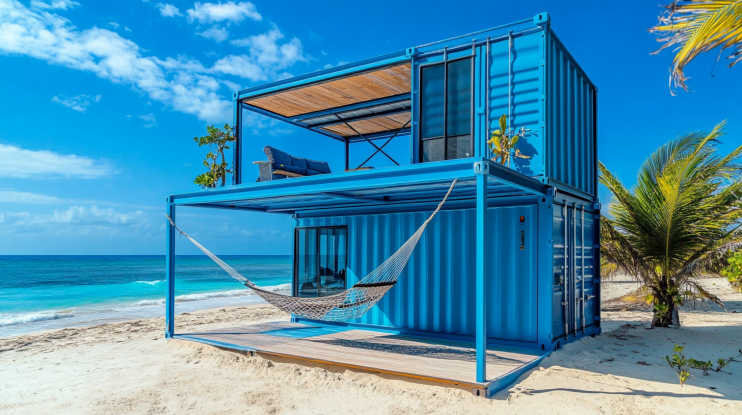
Blue shipping container house
Durability and Strength: The Structural Benefits of Shipping Container Houses
Container houses offer unmatched durability and strength. First, these containers are made from high-grade steel, designed to endure the rough conditions of ocean transport. This steel provides a sturdy frame that resists damage from weather, pests, and even earthquakes. Because of this, shipping container houses can withstand conditions that would damage traditional homes. Therefore, homeowners get a strong and reliable structure that lasts a long time.
Furthermore, the design of shipping containers adds to their strength. These containers are built to be stacked, carrying heavy loads during shipping. This stacking ability translates well into building multi-story homes. As a result, you can create tall, stable structures without needing much extra support. Additionally, the uniform shape and size of containers make building easier. This efficiency not only reduces construction time but also ensures each container home stays strong.
Finally, shipping container houses are flexible yet durable. You can easily expand your home by adding more containers. This modularity means repairs or replacements are straightforward, as individual containers can be swapped out if needed. Moreover, shipping container houses can be reinforced and customized with extra materials like insulation and cladding, boosting their strength and energy efficiency. Thus, shipping container homes offer a mix of durability, strength, and flexibility, making them a sustainable and resilient housing option.
Quick Build Times: Speeding Up Construction with Shipping Container Homes
Shipping container houses offer remarkably quick build times, making them an attractive option for many homeowners. Firstly, these homes start with a ready-made structure, which significantly cuts down the initial construction phase. Traditional homes often require extensive groundwork and framing. However, shipping containers come with a solid, pre-built frame. Consequently, this reduces the time needed for the basic structure by weeks or even months. Moreover, because the container is already a weatherproof shell, you save time on exterior treatments and weatherproofing.
Furthermore, much of the construction work for shipping container houses can be done off-site. For example, containers can be modified and outfitted with windows, doors, and insulation in a factory setting. This off-site construction is often faster and more efficient than on-site building. It isn’t affected by weather delays. Once the modifications are complete, the containers are transported to the site and assembled quickly. This streamlined process can shorten the overall construction timeline by a significant margin. In many cases, a shipping container home can be ready to live in within a few months.
Finally, modern container homes offer flexibility that further speeds up construction. Because these containers are modular, you can add or remove sections with ease. This means you can start with a smaller home and expand it as needed without lengthy construction periods. Additionally, the simple design of containers allows for straightforward customization and finishing. For instance, you can easily add interior walls, electrical wiring, and plumbing without the complications often found in traditional construction. Therefore, the combination of pre-fabricated elements, off-site construction, and modular design makes shipping container houses a fast, efficient, and flexible building option.
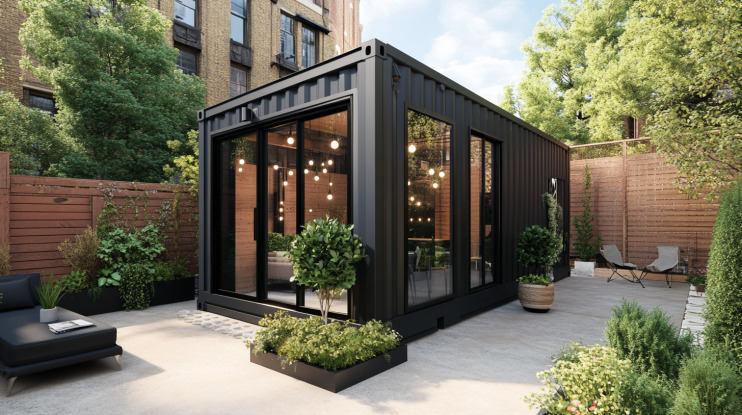
Black shipping container-house
Customizable Interiors: Creating Personalized Spaces in Shipping Container Houses
Shipping container houses offer incredible potential for creating personalized spaces. First, the open layout of a shipping container provides a blank canvas. You can easily divide this space into rooms or leave it open for a loft-style design. For example, many people add partitions to create bedrooms, bathrooms, and living areas. Because the container structure is already strong, you don’t need to worry much about load-bearing walls. This flexibility allows for creative designs that suit individual needs and preferences. Furthermore, you can modify the container’s size and layout to fit your lifestyle.
Moreover, the materials used inside shipping container houses can be tailored to personal tastes. You can choose from a variety of flooring options such as hardwood, tile, or even eco-friendly materials like bamboo. Walls can be finished with drywall, wood paneling, or other decorative elements. Additionally, lighting plays a crucial role in customization. You can install large windows or skylights to bring in natural light, or use a combination of recessed and accent lighting to create different moods. This ability to mix and match materials and finishes helps transform a simple container into a cozy and unique home.
Finally, the modular nature of shipping container houses enhances their customizability. You can easily add more containers to expand your living space. Each container can serve a different function, such as a home office, guest room, or even a greenhouse. Furthermore, containers can be arranged in various configurations, such as side by side, stacked, or in an L-shape. This modular design not only makes it easy to customize but also allows for future expansions. Therefore, shipping container houses offer endless possibilities for creating personalized and functional spaces. For instance, you can start small and grow your home as needed.
Space Optimization: Efficient Design Strategies for Compact Living
Container homes offer unique opportunities for space optimization and efficient design strategies. Firstly, maximizing vertical space is crucial. By utilizing high ceilings, you can create loft areas for sleeping or storage. These lofts free up the main floor for daily activities. Moreover, using built-in furniture, like beds with storage drawers underneath, helps keep the living area uncluttered. This strategy not only saves space but also enhances functionality. Additionally, choosing multi-functional furniture, such as fold-out desks or wall-mounted tables, makes a significant difference in a compact living space.
Furthermore, open floor plans are essential in shipping container houses. By minimizing interior walls, you create a sense of spaciousness. For example, combining the kitchen, dining, and living areas into one open space allows for more natural light and better flow. This approach makes small spaces feel larger and more inviting. Additionally, using sliding doors instead of traditional swinging doors saves space and provides more flexibility in room layouts. These design choices help create a more open and airy feel, even in a compact home.
Finally, incorporating smart storage solutions is vital for efficient space use. Utilizing vertical storage, such as tall shelves and cabinets, makes use of every inch of available space. Hidden storage options, like benches with storage compartments or stairs with built-in drawers, also help keep the home organized without sacrificing space. Moreover, opting for minimalist design principles, like keeping décor simple and using a neutral color palette, can make a small space appear larger and more cohesive. By combining these strategies, shipping container houses can be transformed into comfortable and efficient living spaces that meet all your needs.
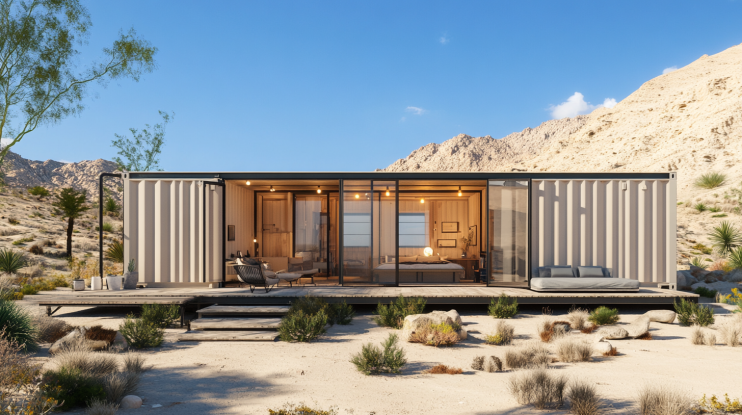
Light brown shipping-container house
Smart Investment in Shipping Container Houses
You can rent or invest in property without breaking the bank by taking a closer look at container homes.
In relatively recent years, a growing number of people, entrepreneurs and developers have turned to using shipping containers as an inexpensive way to build the framework of homes. Around the world, the practice is becoming more popular.
Now, there’s increased interest in learning how to use shipping containers in place of traditional structural framework. Even professional home builders are interested in shipping containers because they’re durable, flexible and cost-effective. Resultantly, they’ve built some of the best shipping container homes in the world.
Before You Draw Up Your Shipping Container Home Design Plans
When used for shipping, a container may last about 20 years. You can acquire a used shipping container for as little as $1,500 or less.
A brand-new container may set you back $10,000. Still, that’s much less than the cost to build out a house from the ground up.
Although shipping containers are relatively inexpensive, you must still transport them to your construction site. Even then, the cost benefits of shipping containers make them a much more affordable alternative compared to traditional construction practices.
Before you begin drawing up your shipping container home plans, you must speak with local officials to make sure it’s legal to use them for construction. You must also learn about local building codes in your area.
The average shipping container’s 20 to 40 feet long, and some are a little longer. A trip to your local seaport will yield containers of varying sizes.
At a shipping yard, you may find containers stacked as many as 10 units high. Typically, you’ll have no problems finding containers for your project.
What may prove more elusive is coming up with an aesthetically pleasing shipping container design. In this regard, it’s a good idea to hire a professional.
An architect can help you create a beautiful shipping container home design. More importantly, however, they can make sure that your shipping container home design complies with local zoning laws and regulations. They’ll also help you to avoid common construction problems.
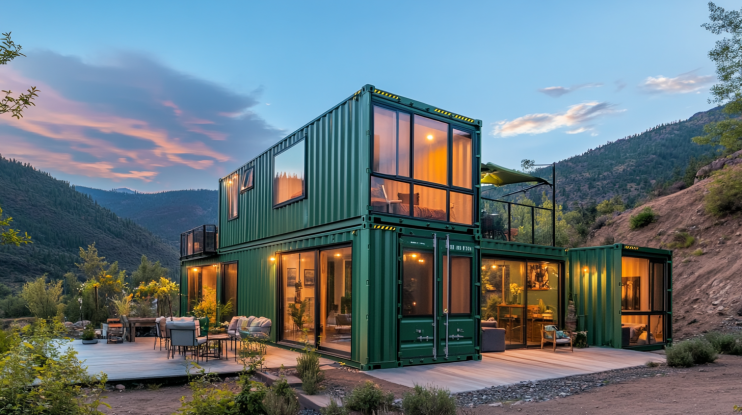
Green shipping-container house
A Few of the Best Shipping Container Homes in the World
The cost of building the average home has risen to nearly $300,000. Alternatively, you can secure a used shipping container for anywhere from $1,500 to $5,000. Some small containers even go for as low as $800.
Often, shipping containers go up for sale because companies have used them to move goods, but they’re too expensive to ship back to their origin point. The use of shipping containers for construction is a sustainable practice. Instead of shipping an empty container or melting it down for scrap, it’s much more beneficial to repurpose an unwanted container as a home.
Shipping containers are extremely durable. They can maintain the integrity of a home in some of the most intense climates in the world.
Manufacturers design shipping containers to stand up to the tough demands of getting moved around by commercial cranes. Because of their design, they stack easily, enabling developers to create innovative home structures.
An unforgiving economy, a growing population and increasing pollution had many people looking for a better way of life. Because of the high cost of building a home, people are looking for more affordable construction alternatives.
Shipping containers are the latest solution that may help many achieve the goal of affordable living. They’re small, inexpensive and environmentally friendly.
Look here to see some of the best houses made out of shipping containers in the world.
Positive Benefits of Container Homes
Shipping container homes are also becoming extremely popular among people who want to get off the grid. They transform environmentally friendly containers into beautiful homes. Best of all, a shipping container home costs even less to build than a tiny house.
Once you step inside a shipping container home, you can’t tell the difference between it and a house built using traditional construction methods. Container homes are a viable green living alternative. If you care about the environment and you want to decrease your carbon footprint, a container home is a great way to do it.
A shipping container home is awesome if you’re into green living. It helps you to care for the environment and do less harm to the land.
They also help you do less damage to your bank account. There are many available shipping containers at seaports around the world. Because of this, they’re available at a relatively nominal cost.
By using a shipping container to build the frame of your home, you can reduce building costs greatly. If you budget correctly, you can even live mortgage-free.
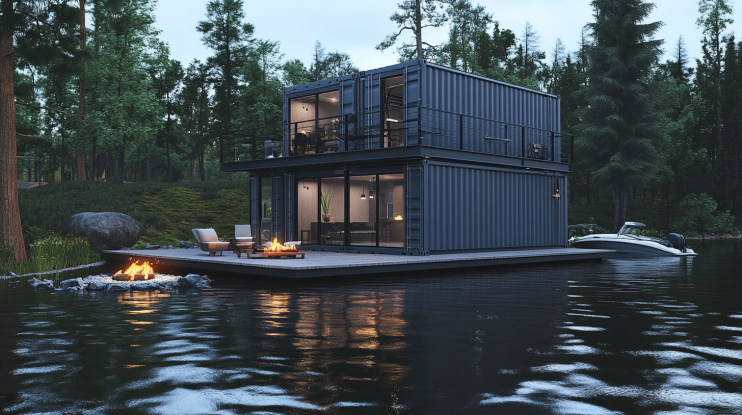
Grey shipping container house
Shipping Container Apartments for Sustainable Income
A growing number of legislators and housing advocates are talking about shipping containers as a viable option to traditional home construction. If you’re an investor, you can use shipping containers to expand your development portfolio quickly and cost-effectively.
Shipping container homes appreciate just like any other home. However, it costs much less to construct one.
Even though shipping container homes are made with square metal boxes, the finished product is visually appealing. They also help affordable housing developers to stretch tight budgets and turn a profit. Shipping containers are also great for building sustainable office spaces.
Minimalist Living: Simplifying Your Lifestyle with Shipping Container Houses
Shipping container houses offer a unique path to minimalist living, helping simplify your lifestyle. Firstly, the compact nature of these homes encourages you to prioritize what truly matters. With limited space, you focus on essentials, reducing clutter and unnecessary possessions. This shift not only makes your home easier to manage but also reduces stress. Additionally, the simplicity of a shipping container house aligns perfectly with minimalist principles. Consequently, you can enjoy a more organized and peaceful living environment.
Moreover, shipping container houses are designed to maximize every inch of space. Clever storage solutions, such as built-in shelves and multi-functional furniture, are essential. For example, a bed with drawers underneath or a fold-out desk can provide extra storage without taking up additional space. This efficient use of space helps keep your home tidy and functional. Furthermore, the open floor plan typical of these homes creates a sense of spaciousness. This design makes even small areas feel larger. By embracing minimalist design, you can create a comfortable and inviting home without the excess.
Finally, the simplicity of shipping container houses extends to their environmental impact. These homes often use recycled materials and are more energy-efficient than traditional houses. By living in a smaller space, you consume fewer resources, which benefits the environment. Additionally, many shipping container homes incorporate sustainable features like solar panels and rainwater harvesting systems. Therefore, choosing a shipping container house not only simplifies your lifestyle but also contributes to a more sustainable future. This minimalist approach helps you live more consciously and intentionally.
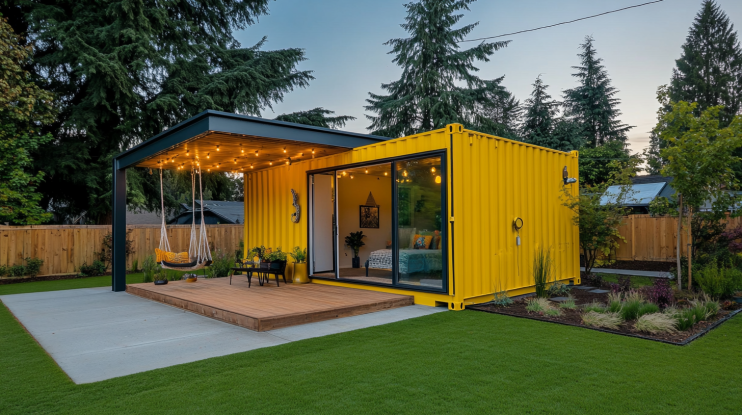
Orange shipping container house
Energy Efficiency: Reducing Your Carbon Footprint with Container Homes
Shipping container houses offer excellent energy efficiency, making them a smart choice for eco-conscious living. First, these homes can be easily insulated to maintain comfortable indoor temperatures. Proper insulation reduces the need for heating and cooling, significantly lowering energy consumption. Consequently, this results in lower utility bills and a smaller carbon footprint. Additionally, using high-quality insulation materials ensures your home stays warm in winter and cool in summer, enhancing overall energy efficiency.
Moreover, shipping container houses can incorporate renewable energy sources, such as solar panels and wind turbines. For example, installing solar panels on the roof of a container home is a popular option. Solar energy can power your entire home, reducing reliance on fossil fuels. Similarly, small wind turbines can provide additional energy, especially in windy areas. Combining these renewable energy sources makes shipping container houses even more energy-efficient. Additionally, these features can lead to energy independence, further reducing your environmental impact.
Finally, shipping container houses promote sustainability by repurposing existing materials. Using containers that would otherwise sit unused helps reduce waste and the demand for new construction materials. Furthermore, you can incorporate other eco-friendly practices, like rainwater harvesting and greywater recycling systems. These systems reduce water usage and promote self-sufficiency. As a result, shipping container houses not only lower energy consumption but also encourage a sustainable lifestyle. By choosing a shipping container home, you contribute to a greener future and reduce your carbon footprint.
Urban Solutions: Addressing Housing Shortages with Shipping Container Houses
Shipping container houses offer innovative solutions to urban housing shortages. First, they provide a quick and cost-effective way to create new housing units. Traditional construction can be time-consuming and expensive. However, shipping container homes use pre-fabricated structures that can be assembled quickly on-site. This speed allows cities to address housing needs more rapidly. Consequently, it helps reduce the number of people waiting for affordable housing. Additionally, the cost savings from using shipping containers can be passed on to residents, making housing more affordable.
Moreover, shipping container houses are versatile and can fit various urban settings. They can be stacked to create multi-story buildings, making efficient use of limited urban space. This vertical expansion is particularly useful in densely populated cities where land is scarce. Additionally, containers can be modified to include essential amenities, ensuring comfortable living conditions. This adaptability allows for a range of housing solutions, from single-family homes to larger apartment complexes. Furthermore, the modular nature of shipping container homes means they can be expanded or reduced in size as needed, providing flexibility for urban planners.
Finally, shipping container houses promote sustainability in urban development. By repurposing used containers, cities can reduce waste and the demand for new construction materials. These homes are also energy-efficient, often incorporating features like solar panels and rainwater harvesting systems. Additionally, the durability of shipping containers means they have a long lifespan, reducing the need for frequent repairs or replacements. Therefore, shipping container homes not only address immediate housing shortages but also contribute to long-term sustainable urban living. By embracing this innovative housing solution, cities can create more affordable, efficient, and eco-friendly living spaces for their residents.
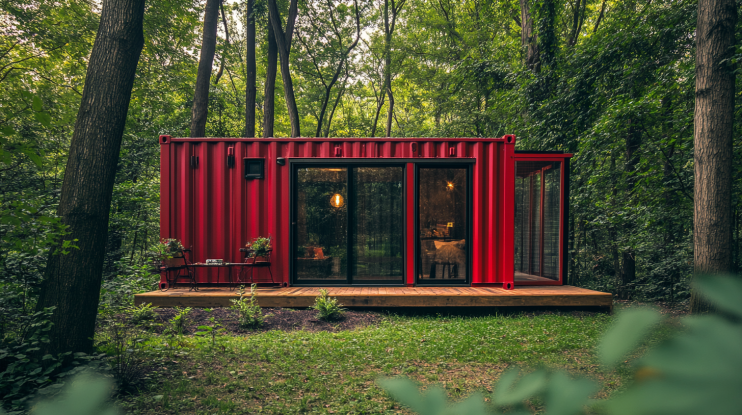
Red shipping container house
Creative Design Ideas: Transforming Shipping Containers into Stylish Homes
Shipping container houses offer a fantastic opportunity for creative design. First, the unique structure of shipping containers allows for innovative layouts. You can stack them, place them side by side, or even arrange them in an L-shape. For example, stacking containers can create multi-level homes with separate spaces for living, working, and sleeping. Additionally, you can cut out sections to add large windows or doors, flooding your home with natural light. This flexibility lets you design a home that is both functional and stylish. Consequently, your home can have a modern, industrial look with a touch of creativity.
Furthermore, the interior of shipping container houses can be customized to reflect personal style. You can use a variety of materials to finish the walls, floors, and ceilings. For instance, using reclaimed wood for flooring can add warmth and character. On the other hand, sleek metal finishes can give your home a contemporary feel. Additionally, built-in furniture like benches with storage or fold-out desks can save space while adding a unique touch. Incorporating these elements not only makes the space practical but also enhances its aesthetic appeal. Moreover, choosing a cohesive color palette can tie all design elements together, making the interior look harmonious and inviting.
Finally, outdoor spaces in shipping container houses can be just as stylish as the interiors. Creating a rooftop garden or a patio can extend your living space and provide a relaxing area to enjoy nature. You can use the roof of the container for planting flowers or vegetables, making your home eco-friendly. Additionally, adding a deck or a pergola can create a perfect spot for outdoor dining or lounging. These outdoor design ideas not only increase the functionality of your home but also enhance its overall appeal. Therefore, by thinking creatively, you can transform a simple shipping container into a stylish and comfortable home.
Resilience in Harsh Environments: Weatherproofing Shipping Container Houses
Shipping container houses are known for their durability, especially in harsh environments. First, the steel structure of these containers provides a strong foundation that withstands extreme weather conditions. For instance, the corrugated steel walls resist high winds, heavy rain, and even earthquakes. Their compact design helps them stay stable during storms. This inherent strength makes shipping container houses reliable in severe weather. Consequently, homeowners can feel secure knowing their home is built to endure the elements.
Moreover, weatherproofing techniques enhance the resilience of shipping container houses. One effective method is applying a high-quality sealant to prevent water infiltration. This is crucial in areas with heavy rainfall or snow. Additionally, adding insulation helps regulate indoor temperatures, protecting against extreme heat and cold. Spray foam insulation is particularly effective because it seals gaps and provides a moisture barrier. Furthermore, installing double-glazed windows and weatherstripping doors can improve energy efficiency and keep out drafts. These weatherproofing measures not only protect the structure but also make the home more comfortable year-round.
Finally, thoughtful exterior modifications can enhance the weather resistance of shipping container houses. For example, adding a sloped roof helps direct rain and snow away from the home, preventing water damage. Installing gutters and downspouts also aids in managing water runoff. Moreover, exterior cladding, such as wood or metal panels, adds an extra layer of protection against the elements. These modifications improve the home’s durability and offer opportunities for aesthetic enhancements. By combining these strategies, shipping container houses can become resilient, weatherproof homes that withstand harsh conditions.

Vibrant teal shipping-container house
Regulations and Zoning: Navigating Legal Requirements for Container Homes
Shipping container houses are a creative and practical housing solution. However, navigating regulations and zoning laws is crucial for success. First, it is essential to understand local building codes. These codes vary by location and can affect your project significantly. For example, some areas have specific rules about the types of materials that can be used. Additionally, you may need permits for structural modifications. Ensuring your container home complies with these codes helps avoid fines and delays. Therefore, consulting with local authorities early in the planning process is a smart move.
Furthermore, zoning laws play a significant role in where you can place your shipping container house. Zoning laws dictate land use and can restrict where residential buildings can be located. For instance, some zones are designated for commercial use only. In other areas, there might be restrictions on building heights or the number of dwellings allowed on a property. Understanding these zoning laws is crucial to finding a suitable location for your container home. Additionally, some communities may have homeowner association rules that impact your project. Thus, checking all these requirements ensures a smooth building process.
Finally, the approval process for shipping container houses can be complex, but preparation helps. Start by gathering all necessary documentation, including site plans and engineering reports. These documents will be needed for permit applications. Moreover, it can be beneficial to work with professionals who have experience with container homes. Architects and builders familiar with local regulations can streamline the approval process. They can also offer valuable insights into making your design compliant with legal standards. Consequently, thorough preparation and professional assistance can make navigating regulations and zoning laws more manageable.
Real-Life Examples: Inspiring Stories of Unique Shipping Container Houses
Shipping container houses have captivated many with their unique designs and innovative approaches. Firstly, let’s look at the story of the Graceville Container House in Australia. This stunning home, made from 31 shipping containers, showcases modern design and sustainability. The architects used a mix of materials, such as wood and steel, to create a warm, inviting space. The house features open-plan living areas and large windows, which bring in plenty of natural light. Consequently, it stands as a testament to how shipping containers can be transformed into stylish, livable spaces.
Another inspiring example is the container home of Larry Wade in California. Larry wanted an eco-friendly and affordable home, so he chose to build with shipping containers. His house, made from six containers, includes energy-efficient features like solar panels and a rainwater harvesting system. Additionally, the home is designed to maximize space, with clever storage solutions and multi-functional furniture. This project not only demonstrates the cost-effectiveness of shipping container houses but also their potential for sustainability. Larry’s home serves as an excellent model for others looking to build green homes.
Finally, the Redondo Beach House in California offers a different take on container living. This luxurious home is made from eight containers and spans over 3,000 square feet. It includes high-end finishes, a rooftop deck, and a swimming pool. The design blends industrial and contemporary styles, creating a unique aesthetic. The architects incorporated eco-friendly elements such as recycled materials and energy-efficient appliances. This project shows that shipping container houses can also cater to luxury living, providing comfort and style while maintaining environmental consciousness.
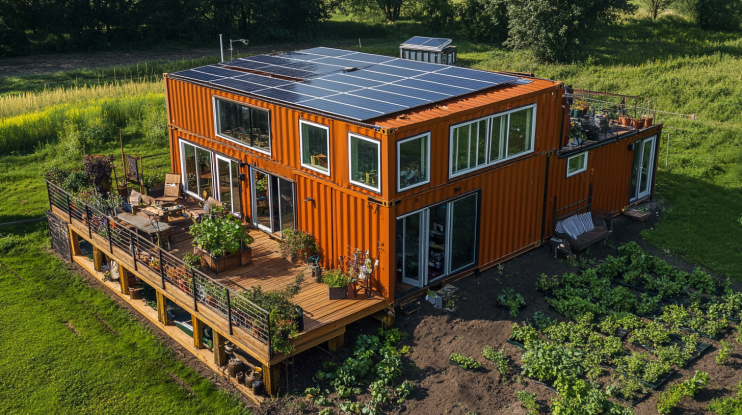
Maron shipping-container house
Start on the Path to Sustainable Housing
SAMAN Portable Office Solutions is a premier supplier of prefabricated structures around the world. They offer a line of over 30 prefabrication construction products, from mobile toilets to rooms to the best shipping container homes around. SAMAN sources its products from the leading manufacturers in the field.
Shipping container houses are a creative and practical housing solution. For those interested in learning about porta cabin prices and how they compare to other portable structures, check out this comprehensive guide on Porta Cabin Prices – A Complete Guide 2024.
Additionally, for information on the versatility and benefits of transportable container storage, visit this detailed article on Transportable Container Storage.
Learn how to transform your shipping container into a beautiful home. Contact SAMAN POS today for a free quote for your next sustainable construction project.
Financial Incentives: Exploring Grants and Loans for Building Container Homes
Shipping container houses are becoming a popular choice for sustainable and affordable living. Firstly, there are various grants available that can help fund these innovative homes. For example, some governments offer grants for eco-friendly housing projects. These grants often support the use of recycled materials and energy-efficient designs. Additionally, non-profit organizations sometimes provide financial assistance for sustainable building projects. By applying for these grants, you can reduce the overall cost of building your container home. Consequently, this makes it more affordable and accessible.
Furthermore, loans specifically designed for alternative housing can be a great financial resource. Several banks and credit unions now offer loans for building shipping container houses. These loans often have favorable terms, recognizing the growing trend of sustainable living. For instance, you might find lower interest rates or longer repayment periods. Moreover, some financial institutions offer green loans, which are designed for eco-friendly projects. These loans not only help you finance your container home but also encourage environmentally responsible construction practices. Additionally, researching and comparing different loan options can help you find the best financial solution for your project.
Finally, combining grants and loans can maximize your financial benefits. By securing both, you can cover a significant portion of your building costs. Start by researching available grants and applying for as many as possible. Next, look for loan options that complement the grants you’ve secured. This combined approach ensures you have sufficient funds to complete your project without financial strain. Additionally, consult with financial advisors or housing experts to navigate the application processes effectively. They can provide valuable insights and help you understand the requirements for each financial incentive.

Shipping Container Homes
FAQ about Shipping Container Homes
1. What are shipping container houses?
Shipping container homes are residential structures made from recycled shipping containers. These containers are repurposed to create sustainable, durable, and affordable living spaces. They can be customized to include all the amenities of a traditional home, such as kitchens, bathrooms, and living areas.
2. Are shipping container homes durable?
Yes, shipping container houses are highly durable. Made from corten steel, they are designed to withstand harsh marine environments, making them resistant to extreme weather conditions, pests, and corrosion. With proper maintenance, they can last for decades.
3. How much do shipping container homes cost?
The cost of a shipping container home can vary widely based on size, design, and location. On average, a basic container home can cost between $10,000 and $35,000. More elaborate designs with high-end finishes and multiple containers can range from $100,000 to $200,000 or more.
4. Are shipping container homes eco-friendly?
Yes, shipping container houses are considered eco-friendly. They repurpose unused containers, reducing waste and the demand for traditional building materials. Many container homes also incorporate sustainable features like solar panels, rainwater harvesting systems, and energy-efficient appliances.
5. Do shipping container houses require special permits?
Yes, building a shipping container home typically requires permits. These can include building permits, zoning approvals, and inspections to ensure the home meets local building codes and safety standards. It’s important to check with local authorities to understand the specific requirements in your area.
6. Can shipping container homes be customized?
Absolutely. Shipping container houses can be highly customized to meet individual preferences and needs. You can add windows, doors, insulation, and interior finishes. Containers can also be stacked or arranged in various configurations to create unique floor plans.
7. How long does it take to build a shipping container home?
The construction time for a shipping container home is generally shorter than for traditional homes. A basic container home can be completed in a few months, while more complex designs may take longer. Off-site prefabrication can further reduce construction time.
8. Are shipping container homes energy-efficient?
Shipping container homes can be very energy-efficient when properly insulated and designed. They can incorporate renewable energy sources like solar panels and wind turbines, as well as energy-efficient heating and cooling systems. Proper insulation is crucial to maintain comfortable indoor temperatures.
9. Where can I place a shipping container home?
Shipping container homes can be placed in various settings, including urban, suburban, and rural areas. However, placement depends on local zoning laws and regulations. It’s essential to check with local authorities to ensure your planned location is suitable for a container home.
10. What are the benefits of living in a shipping container home?
Benefits include affordability, durability, sustainability, and customization. Shipping container houses are also quick to build and can be designed to meet various needs and preferences. Their unique look and eco-friendly nature make them an attractive option for many people.
11. Are there any disadvantages to shipping container homes?
While shipping container homes offer many benefits, there are some potential drawbacks. These can include navigating complex building regulations, ensuring proper insulation, and managing potential rust or corrosion. Additionally, the narrow width of containers can limit design options.
12. Can shipping container homes withstand natural disasters?
Yes, shipping container homes are known for their strength and durability, making them capable of withstanding natural disasters like hurricanes and earthquakes. However, proper anchoring and reinforcement are essential to ensure maximum stability and safety.
 Container Cafe
Container Cafe

















































































